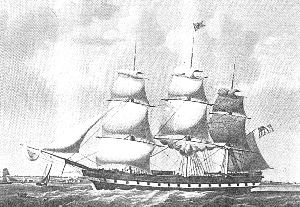Return to Guy Mannering
The Guy Mannering

We have very little information on
the ships most of our ancestors used to travel from Europe to America in the last
half of the 19th century. The following information, compiled from various
sources gives us a good picture of one of the ships plying the trade between
Liverpool, England and New York. The Guy Mannering is first mentioned in
Basil Lubbock's 1925 book, The Western Ocean Packets, as an American
ship, built by William H. Webb who "was responsible for many of the finest
packet ships but also for a goodly number of America's fastest
clippers." A packet ship is defined as "a regularly scheduled
passenger and cargo boat". From America, packet ships carried flour,
grain, cotton and timber eastward to Europe. On their return, as well as
passengers, they carried steel and iron.
In William Armstrong Fairborn's Merchant
Sail, the ships built by Webb are classified as square-rigged,
three-masted, triple-deckers. The Guy Mannering is listed as a
packet/general trader of 190 feet. Launched in March 1849 from Webb's
docks on the East River at Front Street between Sixth and Seventh Streets, she
was a 1,419 ton vessel, one of 18 owned by William and Guion's Black Star
Line which was partly British owned.
Her first east-west voyage sailed from Liverpool on May 22,
1849 and arrived in New York, June 28th, a 38-day voyage. Five years later, on
April 5, 1854 she arrived in New York from Liverpool with 429 passengers.
During this voyage, 8 people died (six of these were children under 2 years of
age; two of whom were from one family). There were also two children born
during the voyage, but one of them who died nine days later, is one of the
unlucky eight. Along with the initial voyage of 1849 and this one in
1854, we know of one other voyage of the Guy Mannering from Liverpool,
in 1856. Fairborn tells of two, west to east, runs between NY and
Cape Clear, the southern most island, off the coast of Ireland, which were
reported to have taken a point-to-point record of nine days. We do not
have any information about the dates of these voyages and nothing is heard of
this ship after the voyage of 1856. Many other ships employed on this
route were later redirected to the California trade.
Because so many immigrants died during the
voyages to America in the 1840-70's, the term "Coffin ships"
became an effective way to describe the ships generally making the
trip. The question is if the Guy Mannering should be considered
as such. According to Edward Laxton in his 1996 book The Famine Ships,
an American built ship like the Guy Mannering had to conform to US
Passenger Laws requiring more space and food allocation for the steerage
passengers than ships registered in Britain. Thus, she would not generally be
classified today as a "famine ship". However, many ships built in
America had the copper bottom attached in England prior to their first return
trip. With part British ownership, there is question as to which laws governed
treatment of the passengers on the Guy Mannering and whether she could
be classified as one of the infamous "coffin ships." From the
one passenger list that identifies the dead, we can see that, in reality, mortality
seems to have been low.
Contributed by Jerry Tuttle

© Common Law copyright 2001 batboy, ltd.
Last updated: September 30, 2001


